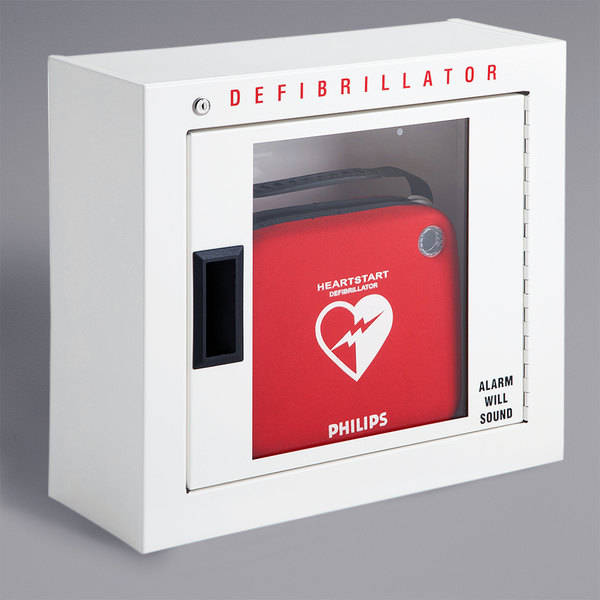AED’s in the Community
What are AED’s and how do they work?
An AED or Automatic External Defibrillator is a small portable device used to restore a heartbeat in a person suffering from sudden cardiac arrest. This is done by measuring the person’s heartbeat and electrical rhythm and if appropriate, administering an electrical shock to the heart to restore a normal rhythm.
AED’s are a simple device to operate, yet very sophisticated in what they do. An AED typically has one or two switches on them. One switch will turn on the device, the other will deliver the shock. The term Automatic means that the device will automatically analyze the patient’s heart rhythm, determine if there is a shockable rhythm, then set the correct power level and alert the user that it is ready. The AED will only deliver the shock when the user presses the shock button.
When the device is opened and turned on (some will turn on when the lid is opened), the device will give prompts to follow. The AED will direct the user to place the pads on the patient’s chest, once the AED senses the pads are on, it will then prompt the user to stay clear of the patient, do not touch the patient. This prevents an error in the heart rhythm analysis, which may cause an incorrect shock or no shock at all.
If the AED detects one of two rhythms, either Ventricular Tachycardia (very rapid heart rate) or Ventricular Fibrillation (no heartbeat, but the heart is “quivering”) the AED will announce “Shock Advised” and start charging up for the shock to be delivered. Once the AED is ready, it will say to stay clear of the patient and deliver the shock. The shock button is usually placed in the center of the device and will blink or glow brightly and have a warning tone. The user must make sure no one is touching the patient before delivering the shock, otherwise, that person touching the patient may be shocked instead of the patient.
A simple way to remember how to use an AED is to remember the phrase; “Power on, follow the prompts”.
When to use an AED?
When someone suffers sudden cardiac arrest, it means that the heart is no longer beating, or is quivering in a way that does not pump blood. Early CPR with AED defibrillation has been proven to greatly increase survivability in patients who suffer from sudden cardiac arrest. If you find a person who is not breathing, check the area around you to ensure you are not in danger. Call for help, call 911 and put it on speakerphone and follow the instructions of the 911 dispatcher. Look for chest rise for about 10 seconds.
If the patient is not breathing, and you have been trained in CPR, otherwise know how to administer CPR, or instructed by the 911 dispatcher, begin CPR. Place your hands in the center of the chest, and push hard, deep and fast. About 2 inches deep on and adult, 1 ½ inches on a child. Do compressions at 100 to 120 beats per minute. If you can give rescue breaths, do so after every 30 compressions. If you are not able to give rescue breaths, compression-only CPR is advised. When the AED arrives, turn it on and follow the prompts. The pads have a picture on them showing proper placement. If a shock is delivered resume CPR. The AED will analyze the patient every two minutes, follow the prompts and resume CPR.
In the case where the AED does not deliver a shock, this doesn’t necessarily mean hope is lost, only that the rhythm is not shockable. When EMS arrives, we have tools and drugs we can use to treat the patient, and continuous high-quality CPR is the patient’s best chance of survival.
Will you get in trouble if you use an AED and the patient dies?
In Washington State, we have a Good Samaritan Law. RCW 4.24.300 states that if someone provides care to a patient, and does not expect to be paid or compensated, and who does not commit an act of gross negligence or willful or wanton misconduct shall be immune from civil liability for damages.
Simply put, if you try to help someone, and don’t expect to be paid, and don’t do something you know you shouldn’t do, you may be protected under the law from liability, even if the results are poor.
Early high-quality CPR with AED application saves lives. If you are interested in learning more or becoming CPR certified, please contact the Ambulance Department at Forks Community Hospital for class times and locations. 360-374-6271 ext. 625.
Tim Wade – Forks Community Hospital Ambulance Supervisor / RMVAC Liaison
Disclaimer: This column is not intended as a diagnosis or recommended treatment of a specific condition, nor is it intended to provide legal advice or to absolve anyone from legal liability. Answers are not a replacement for an individual medical evaluation. Individual health concerns should be evaluated by a licensed clinician.


